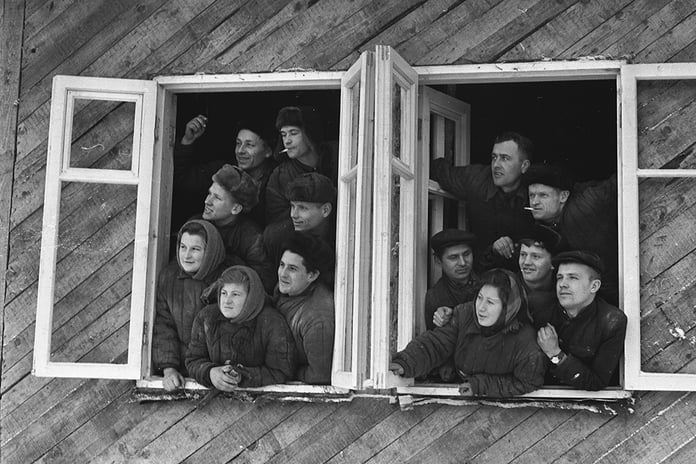The Novopolotsk project organically fits into the era of Nikita Sergeevich Khrushchev, known not only for the glorification of corn as the queen of the fields, but also for a large-scale chemistry program. In 1954, the site near Polotsk was considered the most promising for the construction of an oil refinery north of the BSSR, a year later specialists from the Lengiprogaz Institute appeared on the site of the future Novopolotsk, and the first city blocks began to be designed in Vitebsk.
A new city was being built by the whole great Soviet country. In March 1958, the construction of one of the largest oil refining complexes in Europe at that time was declared a Komsomol shock construction site. Thousands of young enthusiasts came to the banks of the Dvina, many then stayed there forever. Specialists came mainly from specialized enterprises of the RSFSR – from factories already in operation at that time in Ufa, Kuibyshev, Orsk, Angarsk.
Oleg Aleksandrovich Ktatorov (1919-1974), a brilliant man and an experienced administrator, oversaw the construction of the factory and the city. A street in this part of town, where he started in the late 1950s, is aptly named after him. A native of Khvalynsk, Saratov region, was sent to build Novopolotsk by a special decision of the Central Committee of the CPSU, having behind him rich experience in various oil refineries, including a business trip to China.
At the Novopolotsk construction site, Ktatorov immediately and seriously caught fire, and a real romantic became the director of the incoming mass of romantic Komsomol members. Already in September 1958, in the very first issue of the Znamya Novostroyki newspaper, he colorfully painted the future Novopolotsk: “It is already a large city with several thousand inhabitants … All the streets are paved and landscaped .. There are kindergartens and a nursery, a hospital city, a stadium, a park, shops, a consumer service complex, schools, etc. In the city center there is a bridge over the Western Dvina River, which adorns the city and connects old Polotsk with a young, growing city of oil workers.
The bridge was built in 1962, everything else appeared already in the 1960s, and in 1963 the refinery produced the first Belarusian gasoline. The young city had other name variations: the builder colonies were called Pionerny and Polotsk, by analogy with the Far East Komsomolsk, the name Komsomolsk-on-Dvina was proposed. Among the inhabitants of Polotsk, the expression Neftestroy has long been used.
Much of the new town has retained its unique character to this day. Thus, Novopolotsk still does not have a passenger rail connection. The main street of Novopolotsk, originally called Zelena and since 1960 called Molodezhnaya (its length is 15 kilometers), is also unique. This street became the main character of the feature film “Street Without End” released in 1973 by the famous Belarusian director Igor Dobrolyubov. The film crew got used to the local atmosphere for a long time, and ordinary citizens of Novopolotsk were filmed in crowd scenes. Not only in feature films, but also in documentaries, people of the 1960s and 1970s are smiling and cheerful, many of them have long had impressions of romantic construction. Just like that, smiling and romantic, was the first Komsomol builder Pyotr Blokhin, whose name is one of the main streets of Novopolotsk with the buildings of the Polotsk State University. Blokhin, who lived only 23 years and died absurdly in December 1961 of the flu, became one of the symbols of the budding history of Novopolotsk.
The central street of Novopolotsk became the main character of the film “Endless Street” (1973)
This history, according to the plans approved by the Council of Ministers of the BSSR in the 1970s, was to solemnly end in 2000. The city of regional subordination Novopolotsk was doomed to merge with the former Polotsk, and the number of citizens in the united agglomeration of 280,000 people was also planned. The space on the right bank of the Dvina with the villages of Cherneshchino and Ropno was also to be built. These plans were not kept silent in the offices of the authorities, they were voiced by the voice of the famous Yuri Senkevich in the popular Central Television program “Club of Travelers”. However, with the collapse of the Soviet Union, these projects successfully migrated to the archive, Polotsk and Novopolotsk long and habitually existed as separate cities, although they practically merged on the left bank of the Dvina.
The two cities are united by the Polotsk State University named after Euphrosyne of Polotsk, which celebrates its 55th anniversary in 2023: the university’s history began with a polytechnic institute, including Novopolotsk Industry was in dire need. This industry, after the construction of the Druzhba and Surgut-Polotsk oil pipelines, had a pan-European and European reach, remaining of crucial importance in modern Belarus. The appearance of modern Novopolotsk, which, according to Belstat, as of January 1, 2023 had a population of 96,620, is determined by large Naftan and Polymir factories, university science and significant sports achievements. A well-known water-skiing school far beyond the borders of Belarus has been working here for a long time and successfully, here is one of the main centers of Belarusian biathlon, the famous hammer thrower, Olympic medalist Vadim Devyatovsky is from here, The career of dozens of Belarusian national team hockey players began in Novopolotsk, among whom there are many who played a lot in the brothers Andrey and Sergey Kostitsyn of the National Hockey League. The young city on the Dvina has something and someone to be proud of.
Read the Latest Science and Technology News Today on The Eastern Herald.


